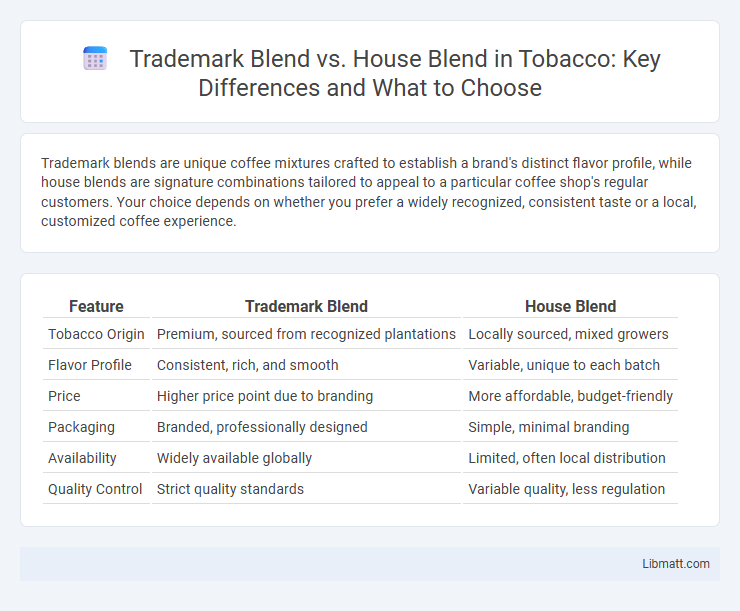Trademark blends are unique coffee mixtures crafted to establish a brand's distinct flavor profile, while house blends are signature combinations tailored to appeal to a particular coffee shop's regular customers. Your choice depends on whether you prefer a widely recognized, consistent taste or a local, customized coffee experience.
Table of Comparison
| Feature | Trademark Blend | House Blend |
|---|---|---|
| Tobacco Origin | Premium, sourced from recognized plantations | Locally sourced, mixed growers |
| Flavor Profile | Consistent, rich, and smooth | Variable, unique to each batch |
| Price | Higher price point due to branding | More affordable, budget-friendly |
| Packaging | Branded, professionally designed | Simple, minimal branding |
| Availability | Widely available globally | Limited, often local distribution |
| Quality Control | Strict quality standards | Variable quality, less regulation |
Introduction to Trademark Blend vs House Blend
Trademark blend refers to a proprietary mix of ingredients or products that a company creates and markets exclusively, often protected by trademark laws to establish brand identity. House blend typically denotes a custom blend crafted by a retailer or producer, serving as their signature offering but not necessarily trademarked or exclusive beyond their brand. Your choice between a trademark blend and house blend depends on whether you prioritize unique brand recognition or a personalized, recognizable product crafted by the vendor.
Understanding Coffee Blends: Trademark vs House
Trademark blends are proprietary mixtures crafted by coffee brands to deliver a unique flavor profile and consistent taste, often protected by trademark rights to distinguish their product in the market. House blends, on the other hand, are signature blends created by individual cafes or roasters to represent their distinct style and appeal to their clientele, emphasizing flavor harmony tailored to their brand identity. Understanding the differences helps you appreciate the intention behind each blend, enabling smarter choices based on flavor complexity and brand originality.
What Is a Trademark Blend?
A trademark blend refers to a unique coffee or tea mixture specifically crafted and owned by a brand, designed to deliver a consistent flavor profile that differentiates it from competitors. Unlike a house blend, which may be a generic mix of beans or leaves, a trademark blend is protected by intellectual property rights, ensuring exclusivity and maintaining the product's premium quality. Your choice of a trademark blend guarantees a distinctive taste experience that cannot be replicated by other brands.
Defining House Blend: Key Characteristics
House blend refers to a unique coffee mix crafted by a cafe or roaster, characterized by a balanced flavor profile tailored to appeal to a broad customer base. It often combines beans from multiple origins, creating a consistent taste that represents the establishment's signature style. Your experience of a house blend offers a reliable and familiar coffee choice, distinct from trademark blends that highlight proprietary recipes or exclusive brand elements.
Flavor Profiles: Comparing Trademark and House Blends
Trademark blends typically showcase a carefully curated combination of distinct flavors aimed at brand consistency, featuring balanced notes of rich chocolate, caramel, and subtle fruit undertones for a smooth, recognizable taste. House blends often vary by establishment but emphasize a well-rounded profile combining nutty, earthy, and sometimes smoky elements to appeal to a broad customer base. Comparing flavor profiles, trademark blends prioritize signature complexity and uniqueness, while house blends focus on versatility and broad appeal within a specific setting.
Sourcing and Quality Differences
Trademark blends often source premium, carefully vetted coffee beans from specific regions to ensure consistent flavor profiles and superior quality, reflecting brand-specific standards. House blends typically combine beans from multiple origins, focusing on balance and affordability, with variable quality depending on the roaster's selection process. The distinct sourcing strategies directly impact the flavor consistency, complexity, and overall consumer experience between trademark and house blends.
Branding and Marketing Strategies
Trademark blends leverage exclusive recipes and unique flavor profiles to build strong brand identity, often protected legally to create market differentiation and customer loyalty. House blends focus on internal brand consistency, offering signature products that reinforce a company's core values and quality standards without necessarily seeking legal protection. Both strategies play crucial roles in marketing by appealing to target audiences through distinct sensory experiences and storytelling that enhance perceived value and brand recognition.
Consumer Preferences and Perceptions
Consumer preferences for trademark blends often emphasize brand recognition and perceived quality, as these blends are consistently marketed with a unique flavor profile tied to the brand's identity. House blends attract consumers seeking a more tailored or local experience, often associated with artisanal craftsmanship and distinctive regional tastes. Perceptions around trademark blends generally center on reliability and prestige, while house blends evoke authenticity and exclusivity, influencing purchasing decisions based on emotional and experiential factors.
Price Comparison: Value and Cost
Trademark blends typically carry a higher price due to exclusive ingredients and proprietary formulations, offering a perceived premium value. House blends are generally more affordable, providing a cost-effective option without sacrificing consistent quality. Your choice depends on whether you prioritize unique branding or budget-friendly options with reliable taste.
Choosing Between Trademark Blend and House Blend
Choosing between trademark blend and house blend depends on brand identity and market differentiation goals. Trademark blends are proprietary mixtures offering unique flavor profiles that establish brand exclusivity and legal protection, whereas house blends combine various elements to create a consistent, recognizable product without exclusivity. Businesses prioritizing distinctiveness and competitive advantage often prefer trademark blends, while those focusing on consistent quality and customer familiarity lean toward house blends.
Trademark blend vs house blend Infographic

 libmatt.com
libmatt.com